The rain that fell in most areas earlier this week combined with a rise in temperatures has seen a jump in predicted growth rates.
Elodie Ruelle’s MoSt Grass Growth Prediction Model (map below)shows a range of predicted growth rates from 54kg DM/ha in Donegal to 76kg DM/ha in Galway.
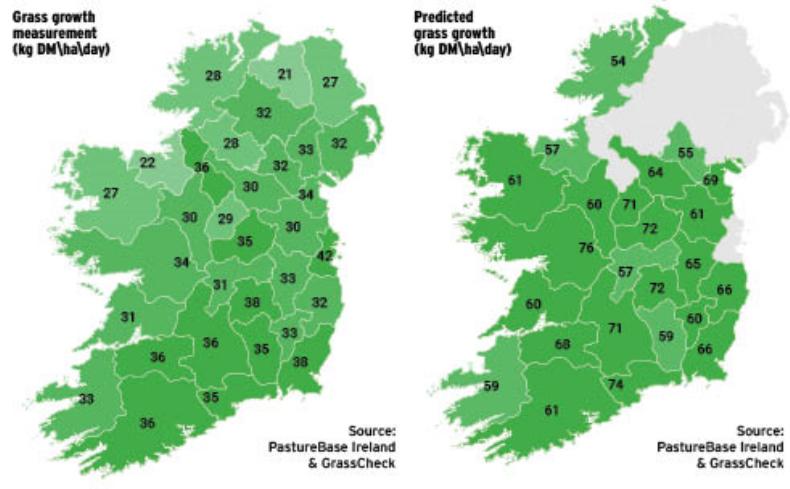
Slow growth over the last number of weeks has seen the need for supplementation in the form of silage and concentrates in order to reduce demand.
As we approach magic day, when growth exceeds demand, it is vital to react quickly to surplus grass. Reduce silage and concentrate accordingly in order to increase demand in line with growth.
Don’t allow the average farm cover to drop below 550kg DM/ha so as to avoid having a shortage of grass going into the next round. On dairy farms, target a cover per livestock unit (C/LU) of between 180-200kgDM/LU and on beef farm target between 15 to 20 days ahead.
Doing a weekly grass walk will help establish what your growth rate has been since the last farm walk and allow you to estimate grass availability.
Keeping grass quality right is vital to ensure good production on all enterprises. Target a pre-grazing cover of 1,400-1,500kg DM/ha.
Barry Reilly – Teagasc Ballyhaise
We have had no grass DM (dry matter) sample lower than 24% for the last 10 days. Pre grazing covers are at around 1600 and with the high DM cows are very content. We are getting an extra grazing in most paddocks. To keep quality grass in the diet we started the second round before the first round was finished. There is 10 percent of the first round still to be grazed half of which we will probably cut for bales if growth improves. The high SCC this spring was as a result of Staph. Aureus. Any cows that sampled positive are kept separate and milked last. The SCC is now down to 69.
Stocking Rate (cows/ha): 4Growth Rate (Kg/day): 36Average Farm Cover (kg/ha): 920Yield (L/cow/day): 26.6Fat %: 4.28Protein %: 3.52Milk Solids (kg/cow): 2.14Supplement fed (kg/cow/day): 3Nicky and Philip Thornton – Cashel, Tipperary
So far we have 70 units of nitrogen out per acre and we are currently following the cows with 27-30 units per acre of protected urea plus sulphur. Cows are milking very well and there is a lot of bulling activity. We do all our own AI and will start breeding on 26 April. This year we will be using sexed semen on the heifers and selected cows will get sexed semen during the first week of breeding. A small number of cows not seen bulling during pre-breeding will be scanned this weekend. We have 80% of the calves weaned, they are out on grass and eating 1.5 kg nuts.
Stocking Rate (cows/ha): 3.35Growth Rate (Kg/day): 37Average Farm Cover (kg/ha): 655Yield (L/cow/day): 32Fat %: 4.0Protein %: 3.65Milk Solids (kg/cow): 2.52Supplement fed (kg/cow/day): 5Bill Brown – Newtonards, Co Down
We are a week into the second rotation. Pre-grazing covers are around 1,500kg DM/ha. Cows are out day and night but we are allocation about 3kg DM silage per cow each day which they get access to at milking times. We reduced demand to 36 in order to slow down the rotation. I don’t want the average farm cover falling too low. We have had no rain for almost a month and there is none forecast for the next week. We are an autumn calving herd and will be finishing breeding on 1 May. This year we put a big focus on using high EBI bulls with a strong fertility index.
Stocking Rate (cows/ha): 2.96Growth Rate (Kg/day): 37Average Farm Cover (kg/ha): 789Yield (L/cow/day): 28Fat %: 4.30Protein %: 3.63Milk solids (kg/cow): 2.29Supplement fed (kg/cow/day): 5Niall O’Meara – Killimor, Co Galway
Growth has been good over the last week. Up to that point, the average farm cover had been reducing week on week. I had introduced silage to the dry cows to reduce the demand for grass.
In early April, paddocks that were low for P and K received 2,500gals/acre injected slurry. The whole farm received another half bag of urea/acre in recent weeks.
Ground that had been grazed by the calves over the winter has good covers of grass but anything grazed in March or April is very slow to come back.
I have four paddocks with heavy covers on the farm. If I need them I will graze them, if not they will be cut for silage in the first half of May.
System: Suckler to weanlingSoil type: HeavyFarm cover (kg DM/ha): 731Growth (kg DM/ha/day): 57Demand (kg DM/ha/day): 38Oisín Kennedy – Aclare, Co Sligo
Calving starts here on 1 April and we have about one-third of cows calved at this point. While the weather has been difficult up to now, ground conditions have been quite good and we are getting cows and calves out to grass on to some of the tougher ground as they calve.
The newly established flock of 30 mule hoggets have all lambed at this stage and are grazing the best available grass on the farm.
The pasture ground has received a half bag of urea/acre so far, but we plan to go again this week once the temperatures improve.
While growth has been very slow this spring, grass supply on the farm is good due to low demand up until this point.
System: Suckler to beefSoil type: Free-drainingFarm cover (kg DM/ha): 1,166Growth (kg DM/ha/day): 30Demand (kg DM/ha/day): 29Diarmuid Murray – Knockcroghery, Co Roscommon
The beef cattle on the outfarm have all the silage ground grazed and a first round on the grazing ground done at this stage. Regrowth on what was grazed in the last fortnight is slow to come back but in the last couple of days growth looks like it has accelerated.
The first rotation was only 21 days which is too quick for this time of year. I have gone in with a kilo of meal to stock for the last 10 days to slow up the rotation.
Ground conditions and grass utilisation is excellent which is a massive help. All pasture ground has received a bag of urea/acre at this stage which was spread in two applications.
System: Dairy calf to beefSoil type: Mostly dryFarm cover (kg DM/ha): 452Growth (kg DM/ha/day): 40Demand (kg DM/ha/day): 26
The rain that fell in most areas earlier this week combined with a rise in temperatures has seen a jump in predicted growth rates.
Elodie Ruelle’s MoSt Grass Growth Prediction Model (map below)shows a range of predicted growth rates from 54kg DM/ha in Donegal to 76kg DM/ha in Galway.

Slow growth over the last number of weeks has seen the need for supplementation in the form of silage and concentrates in order to reduce demand.
As we approach magic day, when growth exceeds demand, it is vital to react quickly to surplus grass. Reduce silage and concentrate accordingly in order to increase demand in line with growth.
Don’t allow the average farm cover to drop below 550kg DM/ha so as to avoid having a shortage of grass going into the next round. On dairy farms, target a cover per livestock unit (C/LU) of between 180-200kgDM/LU and on beef farm target between 15 to 20 days ahead.
Doing a weekly grass walk will help establish what your growth rate has been since the last farm walk and allow you to estimate grass availability.
Keeping grass quality right is vital to ensure good production on all enterprises. Target a pre-grazing cover of 1,400-1,500kg DM/ha.
Barry Reilly – Teagasc Ballyhaise
We have had no grass DM (dry matter) sample lower than 24% for the last 10 days. Pre grazing covers are at around 1600 and with the high DM cows are very content. We are getting an extra grazing in most paddocks. To keep quality grass in the diet we started the second round before the first round was finished. There is 10 percent of the first round still to be grazed half of which we will probably cut for bales if growth improves. The high SCC this spring was as a result of Staph. Aureus. Any cows that sampled positive are kept separate and milked last. The SCC is now down to 69.
Stocking Rate (cows/ha): 4Growth Rate (Kg/day): 36Average Farm Cover (kg/ha): 920Yield (L/cow/day): 26.6Fat %: 4.28Protein %: 3.52Milk Solids (kg/cow): 2.14Supplement fed (kg/cow/day): 3Nicky and Philip Thornton – Cashel, Tipperary
So far we have 70 units of nitrogen out per acre and we are currently following the cows with 27-30 units per acre of protected urea plus sulphur. Cows are milking very well and there is a lot of bulling activity. We do all our own AI and will start breeding on 26 April. This year we will be using sexed semen on the heifers and selected cows will get sexed semen during the first week of breeding. A small number of cows not seen bulling during pre-breeding will be scanned this weekend. We have 80% of the calves weaned, they are out on grass and eating 1.5 kg nuts.
Stocking Rate (cows/ha): 3.35Growth Rate (Kg/day): 37Average Farm Cover (kg/ha): 655Yield (L/cow/day): 32Fat %: 4.0Protein %: 3.65Milk Solids (kg/cow): 2.52Supplement fed (kg/cow/day): 5Bill Brown – Newtonards, Co Down
We are a week into the second rotation. Pre-grazing covers are around 1,500kg DM/ha. Cows are out day and night but we are allocation about 3kg DM silage per cow each day which they get access to at milking times. We reduced demand to 36 in order to slow down the rotation. I don’t want the average farm cover falling too low. We have had no rain for almost a month and there is none forecast for the next week. We are an autumn calving herd and will be finishing breeding on 1 May. This year we put a big focus on using high EBI bulls with a strong fertility index.
Stocking Rate (cows/ha): 2.96Growth Rate (Kg/day): 37Average Farm Cover (kg/ha): 789Yield (L/cow/day): 28Fat %: 4.30Protein %: 3.63Milk solids (kg/cow): 2.29Supplement fed (kg/cow/day): 5Niall O’Meara – Killimor, Co Galway
Growth has been good over the last week. Up to that point, the average farm cover had been reducing week on week. I had introduced silage to the dry cows to reduce the demand for grass.
In early April, paddocks that were low for P and K received 2,500gals/acre injected slurry. The whole farm received another half bag of urea/acre in recent weeks.
Ground that had been grazed by the calves over the winter has good covers of grass but anything grazed in March or April is very slow to come back.
I have four paddocks with heavy covers on the farm. If I need them I will graze them, if not they will be cut for silage in the first half of May.
System: Suckler to weanlingSoil type: HeavyFarm cover (kg DM/ha): 731Growth (kg DM/ha/day): 57Demand (kg DM/ha/day): 38Oisín Kennedy – Aclare, Co Sligo
Calving starts here on 1 April and we have about one-third of cows calved at this point. While the weather has been difficult up to now, ground conditions have been quite good and we are getting cows and calves out to grass on to some of the tougher ground as they calve.
The newly established flock of 30 mule hoggets have all lambed at this stage and are grazing the best available grass on the farm.
The pasture ground has received a half bag of urea/acre so far, but we plan to go again this week once the temperatures improve.
While growth has been very slow this spring, grass supply on the farm is good due to low demand up until this point.
System: Suckler to beefSoil type: Free-drainingFarm cover (kg DM/ha): 1,166Growth (kg DM/ha/day): 30Demand (kg DM/ha/day): 29Diarmuid Murray – Knockcroghery, Co Roscommon
The beef cattle on the outfarm have all the silage ground grazed and a first round on the grazing ground done at this stage. Regrowth on what was grazed in the last fortnight is slow to come back but in the last couple of days growth looks like it has accelerated.
The first rotation was only 21 days which is too quick for this time of year. I have gone in with a kilo of meal to stock for the last 10 days to slow up the rotation.
Ground conditions and grass utilisation is excellent which is a massive help. All pasture ground has received a bag of urea/acre at this stage which was spread in two applications.
System: Dairy calf to beefSoil type: Mostly dryFarm cover (kg DM/ha): 452Growth (kg DM/ha/day): 40Demand (kg DM/ha/day): 26 



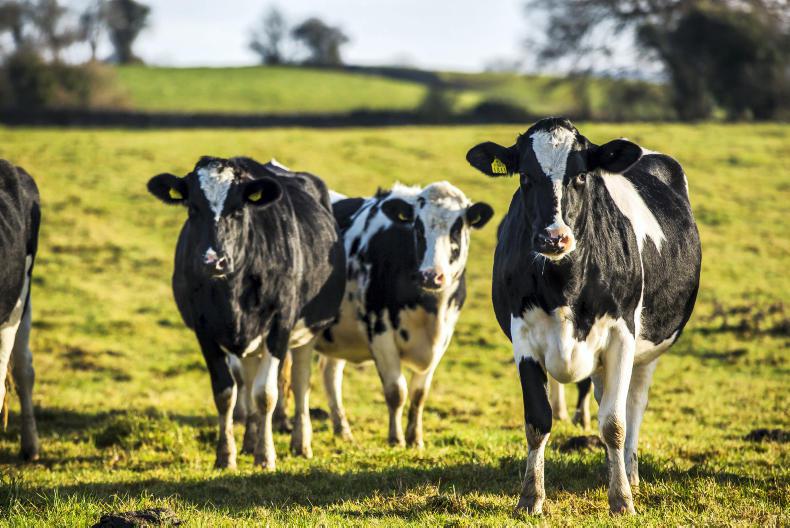

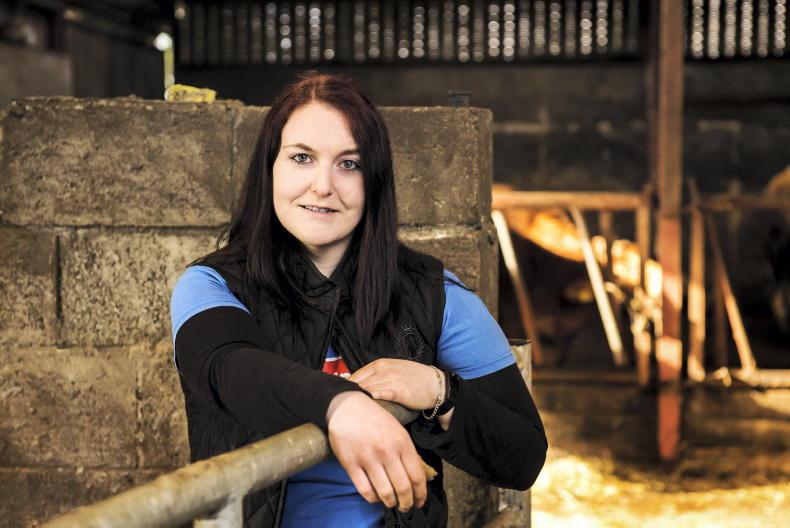

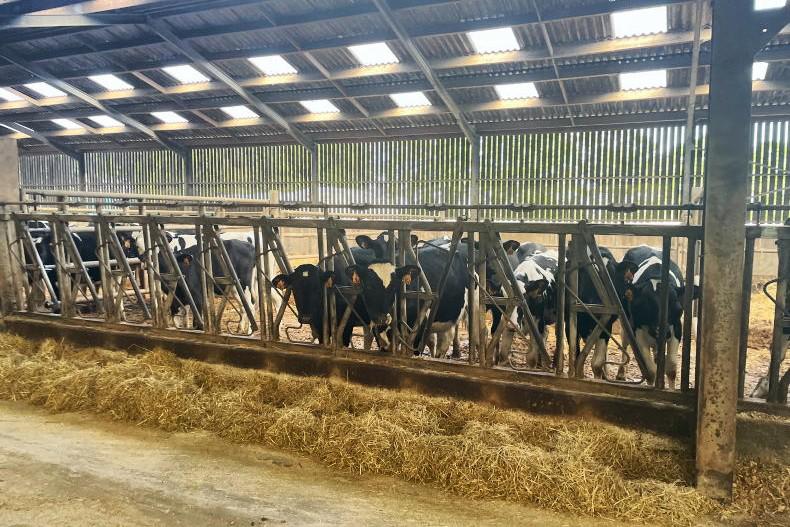
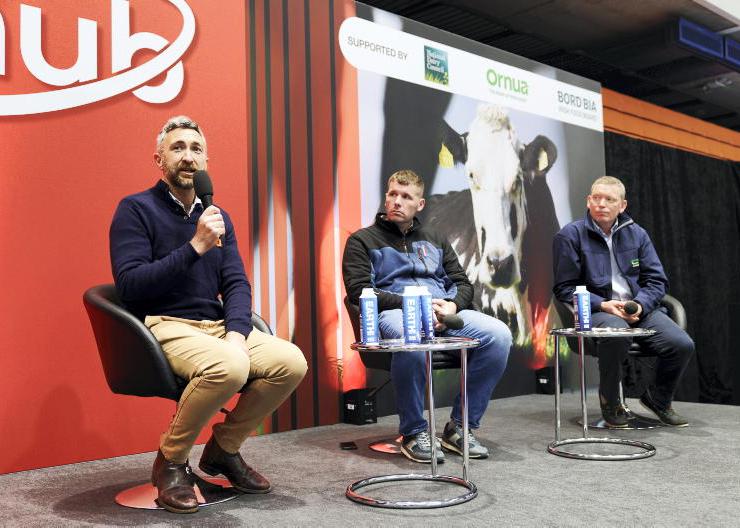
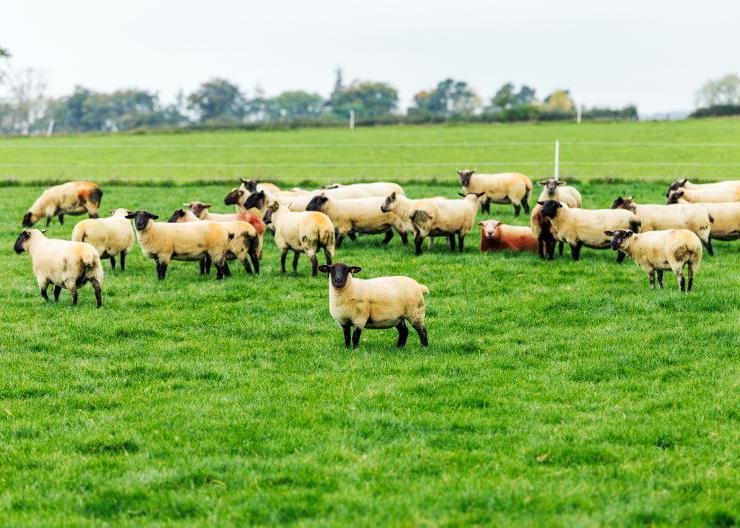
SHARING OPTIONS